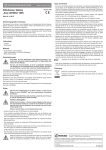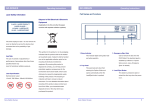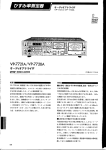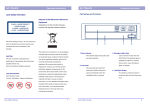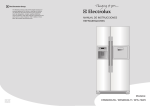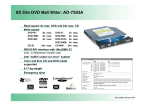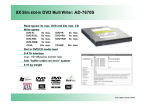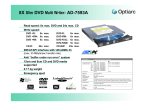Download Sony Optiarc AD-7910A
Transcript
English Laser Safety Information This drive employs a laser. Do not remove the cover or attempt to service this device when connected due to the possibility of eye damage. CAUTION The use of controls or adjustments or performance of procedures other than those specified herein may result in hazardous radiation exposure. Laser Specification: Semiconductor Laser: 330mW, 785nm; 280mW, 661nm 12 Disposal of Old Electrical & Electronic Equipment (Applicable in the EU and other European countries with separate collection systems) This symbol on the product or on its packaging indicates that this product shall not be treated as household waste. Instead it shall be handed over to the applicable collection point for the recycling of electrical and electronic equipment. By ensuring this product is disposed of correctly, you will help prevent potential negative consequences for the environment and human health, which could otherwise be caused by inappropriate waste handling of this product. The recycling of materials will help to conserve natural resources. For more detailed information about recycling of this product, please contact your local Civic Office, your household waste disposal service or the shop where you purchased the product. Slimline DVD Writer Internal ATAPI Drive Names and Functions 1 Front Panel This panel prevents dust from entering the DVD Writer and opens automatically only a little when the Eject button is pushed. 2 Busy Indicator This indicator lights during data read and write operation. 3 Eject Button This button is pressed to open the disc tray/eject the disc when the power is on. 4 Emergency Eject Hole* Instructions CLASS 1 LASER PRODUCT LASER KLASSE 1 LUOKAN 1 LASERLAITE KLASS 1 LASERAPPARAT Use to remove the disc from the DVD Writer if the electrical eject is disabled by software or if power failure occurs. (see „Emergency Eject“ for details) Front View AD-5590, AD-759x 1 2 3 4 Front View AD-763xA, AD-767xS (slot-in) 3 2 13 5 5 Connector This Connector includes Power and I/O BUS. Installation Configuration The drive configures itself independently through the connector. Note: Not all computer hardware supports the intended automatic configuration. Usually this causes that after the drive assembled the computer does not boot any longer. In such case the drives firmware must by changed by qualified personnel. 14 Installing in a host computer While installing a slimline drive, you have to consider that it’s dimension and connector are designed for usage in portable computer and are standardized. If the Slimline drive is not target for a standard slimline system, additional adapters must be procured from an appropriate expert trader. 1. Turn off the computer, other peripherals and unplug all the cords and cables. Then remove the computer cover, face plate, mounting clips, and keeper bracket. Refer to the operation gudie that came with your computer for help with this step. 2. Slide the Slimline DVD Writer into the computer in such a way that you are able to connect the intended plug. 3. Connect the intended plug with the socket on the back of the Slimline DVD Writer. 4. Slide the Slimline DVD Writer into the computer and fix it in the computer cabinet with 4 screws. To avoid damage to the DVD Writer take care that the screws do not reach more than 1.5 mm into the Optiarc Writers cabinet. 5. Reassemble the computer and close the housing cover. Refer to the operation gudie that came with the computer for help with this step. Drive usage Inserting a Disc 1. Press the Eject button. The disc tray will be ejected by about 10mm. 2. Pull the disc tray all the way open by hand. 3. Set the disc into the shaft in the centre of the tray with the label side facing up. 4. Press the disc tray into the DVD Writer calmly by hand. Removing a Disc Instructions Rear View 1. Press the Eject button. The disc tray will be ejected by about 10mm. 2. Pull the disc tray all the way open by hand. 3. Lift the edge of the disc strongly, pressing the shaft in the centre of the tray. 4. Press the disc tray into the DVD Writer drive calmly by hand. Note: If an eject prohibit command has been received from the computer, the disc tray will not be ejected even if the Eject button is pressed. 15 Driver Installation The procedure described below can be used to open the tray of the Optiarc Writer if the EJECT button is disabled by software or a power failure occurs. The software installation starts with activating the reading function of the drive (CD-ROM). If you are using the Slimline DVD Writer with Windows 95/98/ME/ NT/2000/XP or IBM OS/2 Warp, all necessary drivers will be loaded automatically by the operating system. 20 mm 1. Turn off the power to the Slimline DVD Writer. 2. If a disc inside still is spinning wait until it stops. 3. Insert a steel rod (about 0.8 mm in diameter) into the emergency eject hole and push firmly until the cartridge is ejected. A stiff paper clip may be used as steel rod. 16 *) the slot-in drives AD-7630, AD-733 and AD-7670 do not have a emergency eject hole Drivers mentioned above are part of the Operating Systems and are not available from Sony Optiarc. To use the IDE/ATAPI Slimline DVD Writer with MS-DOS and MS-Windows 3.x, you have to install the attached driver software before you can use the Optiarc Writer for the first time. Refer to the README.TXT file on the driver disk for information about installing this driver. This drive supports RPC according to SFF8090v4 (RPC-2). The final setting/definition of the video region code is determined by the fifth DVD video region code change. For Windows 3.xx don’t use the 32 bit hard disk access, because this mode is not supported for DVD drives. If the reading function is available the next step is to achieve the writing function provided by the writing software. Please insert your writing software CDROM into the DVD Writer and use the information provided with the software (if the installation does not starting automatically you have to activate the software installation manually). AD-5590A/S AD-7590A/S Instructions Emergency Eject* AD-7591S AD-7593A/S Support For local support like hotline, service or firmware updates please check following Internet site: http://www.sony-optiarc.eu AD-7630A, AD-7670S AD-7633A 17 General Transfer Rate read DVD-ROM DVD+/-R DVD+/-RW DVD-RAM CD-ROM, CD-R CD-RW, CD-DA CD-ROM XA write DVD-R AD-5590A/S 4500 - 11000 KByte/sec (3.3-8x) 4500 - 11000 KByte/sec (3.3-8x) 4500 - 11000 KByte/sec (3.3-8x) ./. 1500 - 3600 KByte/sec (10-24x) 1500 - 3600 KByes/sec (10-24x) 1050 - 2400 KByes/sec (7-16x) 4500 - 11000 KByte/sec (3.3-8x) AD-7590A/S, AD-7591S, AD-7593A/S 4500 - 11000 KByte/sec (3.3-8x) 4500 - 11000 KByte/sec (3.3-8x) 4500 - 11000 KByte/sec (3.3-8x) 4100 - 6900 KByte/sec (3-5x) 1500 - 3600 KByte/sec (10-24x) 1500 - 3600 KByte/sec (10-24x) 1050 - 2400 KByes/sec (7-16x) 4500 - 11000 KByte/sec (3.3-8x) AD-7630A, AD-7633A, AD-7670S 4500 - 11000 KByte/sec (3.3-8x) 4500 - 11000 KByte/sec (3.3-8x) 4500 - 11000 KByte/sec (3.3-8x) 4100 - 6900 KByte/sec (3-5x) 1500 - 3600 KByte/sec(10-24x) 1500 - 3600 KByte/sec(10-24x) 1050 - 2400 KByes/sec (7-16x 4500 - 11000 KByte/sec (3.3-8x) DVD-R DL 3400 - 8300 KByte/sec (2.5-6x) 3400 - 8300 KByte/sec (2.5-6x) 2700 - 5500 KByte/sec (2-4x) DVD-RW 2700 - 8200 KByte/sec (2-6x) 2700 - 8200 KByte/sec (2-6x) 2700 - 8200 KByte/sec (2-6x) ./. 4100 - 6900 KByte/sec (3-5x) 4100 - 6900 KByte/sec (3-5x) supported speeds supported speeds supported speeds DVD-RAM supported speeds 8x/6x/4x/2x 6x/4x/2x 6x/4x/2x/1x ./. 8x/6x/4x/2x 6x/4x/2x 6x/4x/2x/1x 5x/3x/2x 8x/6x/4x/2x 4x/2x 6x/4x/2x/1x 5x/3x/2x Power Consumption (max.) 8 VA (5V 1.6A) Dimensions (WxHxD) 128 x 12.7 x 129 mm Weight 0.174 kg (AD-7630, AD-7633, AD-7670: 0.16 kg) ≤ 47.5 dB(A) -40° to +65° C 5% to 95 % RH, noncondensing Operating temp. +5° to +50° C Operating humidity 20 % to 80 % RH, noncondensing Laser Specification 330mW, 784nm (CD) 300mW, 661nm (DVD) In compliance wth MultiRead, PC-99, PC-2001, MS Vista Noise Storage temperature Storage humidity DVD+R 4500 -11000 KByte/sec (3.3-8x) 4500 - 11000 KByte/sec (3.3-8x) 4500 - 11000 KByte/sec (3.3-8x) DVD+R9 3400 - 8300 kByte/sec (2.5-6x) 3400 - 8300 kByte/sec (2.5-6x) 3300 - 5500 KByte/sec(2.4-4x) DVD+RW 4500 - 11000 KByte/sec (3.3-8x) 4500 - 11000 KByte/sec (3.3-8x) 4500 - 11000 KByte/sec (3.3-8x) Above specifications are subject to change. CD-R 1500 - 3600 KByte/sec (10-24x) 1500 - 3600 KByte/sec (10-24x) 1500 - 3600 KByte/sec(10-24x) CD-RW 1200 - 3600 KByte/sec 1200 - 3600 KByte/sec 1200 - 2400 KByte/sec (8-16x) Microsoft, Windows, and Windows Vista are registered trademarks Microsoft Corporation, Photo CD is a trademark of Kodak supported speeds supported speeds supported speeds supported speeds supported speeds 8x/6x/4x/2.4x 6x/4x/2.4x 8x/6x/4x/2.4x 24x/16x/8x (8-24x) 24x/20x/10x/4x 8x/6x/4x/2.4x 6x/4x/2.4x 8x/6x/4x/2.4x 24x/16x/8x (8-24x) 24x/20x/10x/4x 8x/6x/4x/2.4x 4x/2.4x 8x/6x/4x/2.4x 24x/16x/8x 16x/10x/4x Write methods DAO (disc at once), SAO (session at once), TAO (track at once) with zero gap, variable or fixed packet, multisession Access Time DVD-ROM (1/3 stroke read, average) 180 msec 180 msec 190 msec CD-ROM (1/3 stroke read, average) 150 msec 150 msec 190 msec Memory Buffer 2 MByte 2 MByte 2 MByte Interface A type: IDE/ATAPI SFF-8020 rev. 2.60, PIO Mode 4/Ultra DMA33 mode 2 support / S type: S-ATA I 1.5Gbps Compatibility DVD-ROM, DVD-Video, DVD-R, +R, DVD-R, +RW, DVD-RW, +RW, High Sierra and ISO 9660, CD-ROM, CD-ROM XA, CD-DA, CD-TEXT, CD-I (FMV), Enhanced Music CD (CD+), PhotoCD (SingleSession/MultiSession), VideoCD (WhiteBook) ecifications • Technische Daten • Spécifications • Dat cnicos • Dati tecnici • Specifications • Technische Date ifications • Datos técnicos • Dati tecnici • Specificatio echnische Daten • Spécifications • Datos técnicos • Da ici • Specifications • Technische Daten • Spécificatio Data-Section




